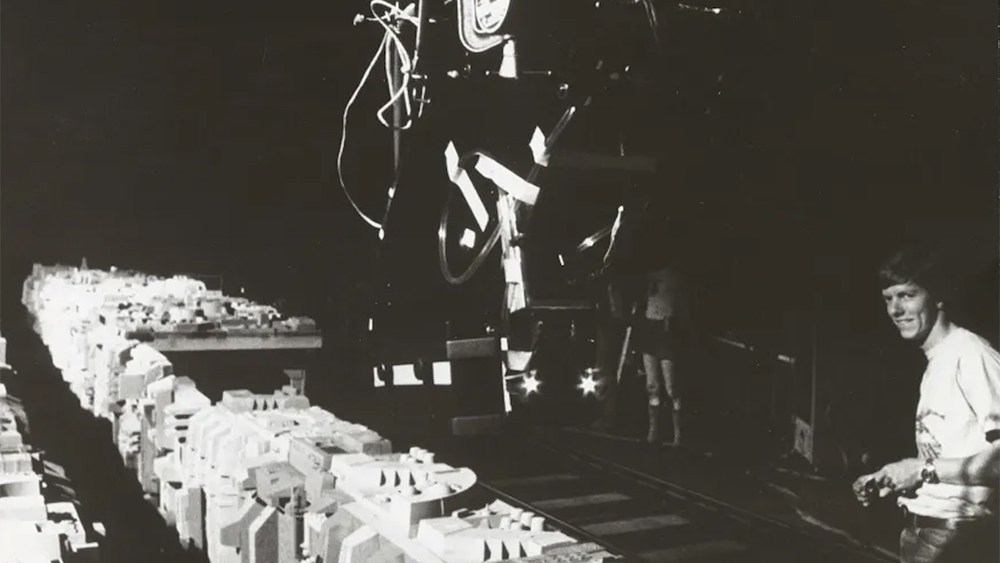When George Lucas decided to make “Star Wars” half a century ago, a core visual effects team was faced with a significant challenge: coming up with a believable way to transport audiences to a galaxy far, far away. Essential to that goal was the development of a new type of motion control camera system: built in a Van Nuys warehouse where the production filmed space scenes, such as the climatic trenches.
Now fans in Southern California can see the historic Dykstraflex camera system, newly restored and in working condition, on display starting Saturday at the Academy Museum of Motion Pictures in honor of May 4, aka Star Wars Day. The system weighs 1,500 kg. and will be demonstrated by VFX vets with a 15-foot track and studio-scale replicas of the Millennium Falcon, which is five feet long, and a 20-inch X-Wing fighter.
Looking back, Richard Edlund, member of the core VFX team that won an Oscar for the Lucasfilm classic, remembers the reaction of Lucas and crew members after an early test demonstrated what was possible with the camera system: “Everyone was shocked because it worked and we knew we could get there.”
Visual effects historian Gene Kozicki notes that the “revolutionary” system changed not only what was possible with visual effects, but also with cinematic storytelling. The Dykstraflex was essentially a computer-controlled movie camera on a boom and track that allowed the VFX team to film spacecraft models and miniatures with precise camera movements such as pans and tilts – movements that looked as if they had been filmed by a camera operator. , while being repeatable and recordable.
“The camera also moved during the exposure, so we could capture motion blur, which was necessary to make these miniatures look like they were on a larger scale and moving at very high speed in the environments they were in,” explains John Dykstra , who remembers that. some crew members began using the term Dykstraflex as the team was developing the system. The name stuck. Dykstra was part of the team that received an Oscar for the VFX in “Star Wars” and he also accepted an Academy Technical Achievement Award for the camera system itself, along with Alvah J. Miller and Jerry Jeffress.
Dykstra and Edlund – who also contributed to development and used the Dykstraflex during production – say the film’s iconic opening shot, of a small ship being chased through space by a massive Star Destroyer, was the most challenging, and the most important thing to get right.
“I was really worried about the opening shot,” Edlund admits. “That shot was so important to the success of the film. It would either grab the audience or lose the audience.”
Dykstra recalls that the shot was filmed early in production: “It’s probably the shot most people remember from the movie because of the implied change of scale in the beginning – the whole idea of the little ship with a Star Destroyer over it. ”
Regarding the climatic trenches that led to the destruction of the Death Star, Edlund says that the model shop built a trench about two hundred feet wide and two hundred feet high, which was filmed on a track over forty feet long. It took several passes to get a shot of the length needed for the film.
Looking back on the period during which the team worked on these scenes, Dykstra recalls that releasing studio 20th Century Fox “George Lucas had quite a hard time getting this space opera, as it was called, done. There wasn’t much enthusiasm in the studio.” He admits that the recordings made with the Dykstraflex were also difficult to understand. “The studio managers, for the most part, had no technical background and weren’t really interested in the technical background, so it was very difficult to explain it to them,” he recalls. “I don’t think anyone realized what the movie was until it was cut. I don’t even think George knew what he had.”
The Dykstraflex was acquired from Lucasfilm by the Academy’s Science and Technology Council in 2008 and restored to working condition by a dedicated team of Academy members and others, according to Brooke Benton, governor of the VFX department. VFX affiliate Kozicki adds that the restoration was “a multi-year effort that involved a lot of historical research, as some parts had to be repaired and missing components had to be recreated.” The Dykstraflex was housed at the Pickford Center for Motion Picture Study in Hollywood until it was moved to the Academy Museum, where it will be on display until July 8. The museum’s May 4 celebration also includes showings of “Return of the Jedi.” and “Rogue One: A Star Wars Story,” as well as a visit with several droids.
Edlund reflects on the impact of “Star Wars,” recalling its release as the birth of the event film “where audiences come to the theater and cheer for the heroes and hiss at the villains.” ‘Star Wars’ really woke up the whole country and the whole world.”





















